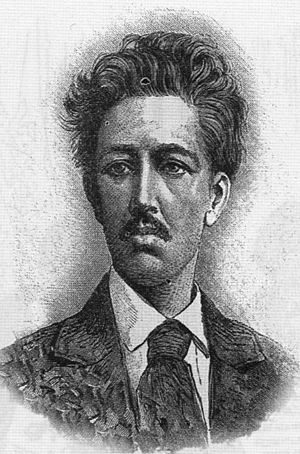Manuel Acuña facts for kids
Quick facts for kids
Manuel Acuña
|
|
|---|---|
 |
|
| Born | August 27, 1849 Saltillo, Coahuila, Mexico
|
| Died | December 6, 1873 (aged 24) |
| Nationality | Mexican |
Manuel Acuña Navarro (born August 27, 1849 – died December 6, 1873) was a Mexican writer from the 1800s. He was best known for his poetry. He also wrote some novels and plays. Manuel Acuña passed away at the young age of 24.
Contents
Early Life and Education
Manuel Acuña was born in Saltillo, Coahuila, Mexico. His parents were Francisco Acuña and Refugia Navarro. He learned to read and write when he was very young. His parents even received his first letter.
He first studied at the College Josefino in Saltillo. Around 1865, he moved to Mexico City. There, he became a student at the College of San Ildefonso. He studied subjects like mathematics, Latin, French, and philosophy.
In January 1868, Acuña began studying medicine. He enrolled at the Universidad Nacional Autónoma de México. He was a very good student, but he never finished his medical degree.
During his first months there, he lived in a room at the old Santa Brígida convent. Later, he moved to a room at the medical school. This was the same room where another Mexican poet, Juan Díaz Covarrubias, had lived.
This room became a popular meeting spot. Many young writers of that time gathered there. Some of his friends included Juan de Dios Peza, Manuel M. Flores, Agustín F. Cuenca, and Gerardo M. Silva. They would share ideas and discuss their works.
Manuel Acuña lived during a time when new ideas were popular in Mexico. People were interested in science and reason. At the same time, a style of poetry called Romanticism was also growing.
Literary Career
Manuel Acuña started his writing career in 1868. It was a short but impactful career. He first became known for a poem he wrote. This poem was for the death of his close friend, Eduardo Alzúa.
In the same year, he helped start a group called the Nezahualcóyotl Literary Society. This happened during a time of cultural growth in Mexico. Acuña, along with Agustín F. Cuenca and Gerardo Silva, presented his first poems there.
The works from this society were published in a magazine called El Anáhuac. They also appeared in a newspaper pamphlet called “Literary Essays of the Nezahualcóyotl Society.” This pamphlet is important because it included eleven of Acuña's poems and an article he wrote. By the age of 24, he had already made a name for himself.
On May 9, 1871, a play he wrote was performed. It was called El pasado (The Past). The audience and critics really liked this play. It helped him become known as an outstanding poet.
Rosario de la Peña y Llerena was a woman who was very important in Acuña's later years. Her home was a frequent meeting place for poets. They would share their new poems and discuss philosophy.
Some of his famous works include Nocturno and Entonces y hoy.
Death and Legacy
Manuel Acuña passed away on December 6, 1873. On the day he died, his friends were with him at the medical school.
On December 10, Acuña was buried at the “Campo Florido” cemetery. Many people attended his funeral. Representatives from literary and scientific groups were there. A large crowd of his admirers also came to say goodbye.
His brother, his best friend Juan de Dios Peza, Gustavo Baz, Eduardo F. Zárate, and Justo Sierra spoke at his burial. Later, his body was moved to “La Rotonda de los hombres ilustres.” This is a special place where famous Mexicans are honored. A monument was built there for him.
Role in Mexican Literature
Manuel Acuña was a very well-known writer in Mexico. Many other writers were his friends. He influenced many of them in their own writing. His friends wanted to remember him for a long time.
After Acuña’s death, the famous Cuban writer José Martí wrote a poetic letter to honor him.
See also
 In Spanish: Manuel Acuña para niños
In Spanish: Manuel Acuña para niños

